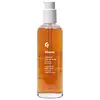What's inside
What's inside
 Key Ingredients
Key Ingredients

 Benefits
Benefits

 Concerns
Concerns

 Ingredients Side-by-side
Ingredients Side-by-side

Water
Skin ConditioningDecyl Glucoside
CleansingCocamidopropyl Betaine
CleansingChamomilla Recutita Flower Water
MaskingSodium Lauroyl Sarcosinate
CleansingGlycerin
HumectantSodium Lauroyl Lactylate
EmulsifyingNiacinamide
SmoothingVitis Vinifera Juice Extract
AntioxidantLactic Acid
BufferingSorbitol
HumectantVitis Vinifera Fruit Extract
Skin ConditioningSaccharomyces Ferment
Skin ConditioningPassiflora Incarnata Fruit Extract
Skin ConditioningCalendula Officinalis Flower Extract
MaskingMalic Acid
BufferingArginine
MaskingTocopherol
AntioxidantPropanediol
SolventSodium Laurate
CleansingEthylhexylglycerin
Skin ConditioningCitric Acid
BufferingSodium Hydroxide
BufferingPentylene Glycol
Skin ConditioningCaprylyl Glycol
EmollientPotassium Sorbate
PreservativeSodium Benzoate
MaskingWater, Decyl Glucoside, Cocamidopropyl Betaine, Chamomilla Recutita Flower Water, Sodium Lauroyl Sarcosinate, Glycerin, Sodium Lauroyl Lactylate, Niacinamide, Vitis Vinifera Juice Extract, Lactic Acid, Sorbitol, Vitis Vinifera Fruit Extract, Saccharomyces Ferment, Passiflora Incarnata Fruit Extract, Calendula Officinalis Flower Extract, Malic Acid, Arginine, Tocopherol, Propanediol, Sodium Laurate, Ethylhexylglycerin, Citric Acid, Sodium Hydroxide, Pentylene Glycol, Caprylyl Glycol, Potassium Sorbate, Sodium Benzoate
Water
Skin ConditioningCoco-Glucoside
CleansingGlycerin
HumectantDecyl Glucoside
CleansingCocamidopropyl Betaine
CleansingAloe Barbadensis Extract
Skin ConditioningSodium Cocoyl Glutamate
CleansingMaltooligosyl Glucoside
Skin ConditioningHydrogenated Starch Hydrolysate
HumectantSodium Methyl Cocoyl Taurate
CleansingCamellia Sinensis Leaf Extract
AntimicrobialCaffeine
Skin Conditioning3-O-Ethyl Ascorbic Acid
Skin ConditioningPhenoxyethanol
PreservativeEthylhexylglycerin
Skin ConditioningCitric Acid
BufferingSodium Gluconate
Skin ConditioningParfum
MaskingCI 19140
Cosmetic ColorantCI 42090
Cosmetic ColorantWater, Coco-Glucoside, Glycerin, Decyl Glucoside, Cocamidopropyl Betaine, Aloe Barbadensis Extract, Sodium Cocoyl Glutamate, Maltooligosyl Glucoside, Hydrogenated Starch Hydrolysate, Sodium Methyl Cocoyl Taurate, Camellia Sinensis Leaf Extract, Caffeine, 3-O-Ethyl Ascorbic Acid, Phenoxyethanol, Ethylhexylglycerin, Citric Acid, Sodium Gluconate, Parfum, CI 19140, CI 42090
 Reviews
Reviews

Ingredients Explained
These ingredients are found in both products.
Ingredients higher up in an ingredient list are typically present in a larger amount.
Citric Acid is an alpha hydroxy acid (AHA) naturally found in citrus fruits like oranges, lemons, and limes.
Like other AHAs, citric acid can exfoliate skin by breaking down the bonds that hold dead skin cells together. This helps reveal smoother and brighter skin underneath.
However, this exfoliating effect only happens at high concentrations (20%) which can be hard to find in cosmetic products.
Due to this, citric acid is usually included in small amounts as a pH adjuster. This helps keep products slightly more acidic and compatible with skin's natural pH.
In skincare formulas, citric acid can:
While it can provide some skin benefits, research shows lactic acid and glycolic acid are generally more effective and less irritating exfoliants.
Most citric acid used in skincare today is made by fermenting sugars (usually from molasses). This synthetic version is identical to the natural citrus form but easier to stabilize and use in formulations.
Read more about some other popular AHA's here:
Learn more about Citric AcidCocamidopropyl Betaine is a fatty acid created by mixing similar compounds in coconut oil and dimethylaminopropylamine, a compound with two amino groups.
This ingredient is a surfactant and cleanser. It helps gather the dirt, pollutants, and other impurities in your skin to be washed away. It also helps thicken a product and make the texture more creamy.
Being created from coconut oil means Cocamidopropyl Betaine is hydrating for the skin.
While Cocamidopropyl Betaine was believed to be an allergen, a study from 2012 disproved this. It found two compounds in unpure Cocamidopropyl Betaine to be the irritants: aminoamide and 3-dimethylaminopropylamine. High-grade and pure Cocamidopropyl Betaine did not induce allergic reactions during this study.
Learn more about Cocamidopropyl BetaineDecyl Glucoside is a glucose-based surfactant and emulsion stabilizer. It is created by reacting glucose with the fatty acids from plants.
Surfactants help clean the skin by trapping oil, sebum, and dirt to be washed away. As an emulsion stabilizer, it stabilizes the ingredients in a product by preventing them from separating.
This ingredient is biodegradable and non-toxic. This ingredient is commonly found in baby shampoos.
Decyl Glucoside is sometimes used to stabilize the UV filter Tinosorb.
Learn more about Decyl GlucosideEthylhexylglycerin (we can't pronounce this either) is commonly used as a preservative and skin softener. It is derived from glyceryl.
You might see Ethylhexylglycerin often paired with other preservatives such as phenoxyethanol. Ethylhexylglycerin has been found to increase the effectiveness of these other preservatives.
Glycerin is already naturally found in your skin. It helps moisturize and protect your skin.
A study from 2016 found glycerin to be more effective as a humectant than AHAs and hyaluronic acid.
As a humectant, it helps the skin stay hydrated by pulling moisture to your skin. The low molecular weight of glycerin allows it to pull moisture into the deeper layers of your skin.
Hydrated skin improves your skin barrier; Your skin barrier helps protect against irritants and bacteria.
Glycerin has also been found to have antimicrobial and antiviral properties. Due to these properties, glycerin is often used in wound and burn treatments.
In cosmetics, glycerin is usually derived from plants such as soybean or palm. However, it can also be sourced from animals, such as tallow or animal fat.
This ingredient is organic, colorless, odorless, and non-toxic.
Glycerin is the name for this ingredient in American English. British English uses Glycerol/Glycerine.
Learn more about GlycerinWater. It's the most common cosmetic ingredient of all. You'll usually see it at the top of ingredient lists, meaning that it makes up the largest part of the product.
So why is it so popular? Water most often acts as a solvent - this means that it helps dissolve other ingredients into the formulation.
You'll also recognize water as that liquid we all need to stay alive. If you see this, drink a glass of water. Stay hydrated!
Learn more about Water